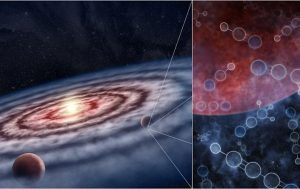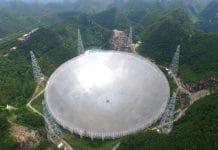Humankind’s search for extraterrestrial life may have gotten a needed boost. The Telegraph reports “Chances of alien life in our galaxy are much more likely than first thought after scientists found ‘significant amounts’ of large organic molecules surrounding young stars.” Dr. John Ilee, Research Fellow at the University of Leeds, led a team of astrophysicists that studied these molecules, revealing “chemical conditions that resulted in life on Earth could exist more widely across the Galaxy.”
This is an important discovery because the molecules function as building blocks, or precursor materials for more complex life. As Ilee points out, “These large complex organic molecules are found in various environments throughout space. Laboratory and theoretical studies have suggested that these molecules are the ‘raw ingredients’ for building molecules that are essential components in biological chemistry on Earth, creating sugars, amino acids and even the components of ribonucleic acid (RNA) under the right conditions.”

To detect these molecules in deep space, Dr. Ilee and his team used Atacama Large Millimeter/submillimeter Array (ALMA), an integrated collection of “parabolic antennas that can operate together to work as a single giant telescope.” By scanning the skies for radio waves in millimetric and submillimetric wavelength, ALMA is able to detect “unique spectral ‘fingerprints’ that each of these organic molecules emits.
To locate these fingerprints, the scientists used ALMA to look deeply at the material swirling around protoplanetary discs, which are rotating circumstellar discs of dense gas and dust surrounding a young newly formed star. Astronomers hypothesize that these discs function as nurseries for the creation of new planets or planetary systems.
Dr. Catherine Walsh, one of the five co-principal investigators leading the study explained, “The power of ALMA has allowed us to measure the distribution and composition of material that is actively building planets around nearby young stars for the first time. The telescope is powerful enough to do this even for large complex molecules that are the precursors for life.”
Specifically, the researchers were probing for three molecules – cyanoacetylene (HC3N), acetonitrile (CH3CN), and cyclopropenylidene (c-C3H2) – in five protoplanetary disks, known as IM Lup, GM Aur, AS 209, HD 163296 and MWC 480. The idea is that that these discs “feed” a young planet these raw materials in order to potentially grow future life.
As a recent press release from the University of Leeds elaborates, “. . .it is thought that the young Earth was seeded with material via impacts of asteroids and comets that had formed in the protoplanetary disk around the Sun. But scientists were uncertain whether all protoplanetary disks contain reservoirs of complex organic molecules capable of creating biologically significant molecules.”
ALMA then, provides the technology to eventually answer the question of whether or not there is sufficient material in these discs to provide the necessary components for planets, such as Earth, to form and then support life forms. As Dr, Walsh states, “The key result of this work shows that the same ingredients needed for seeding life on our planet are also found around other stars. It is possible that the molecules that are needed to kickstart life on planets are readily available in all planet-forming environments.”
This knowledge allows scientists to generalize that these same conditions may hold true across multiple galaxies and even the universe. Moreover, these discoveries potentially build a bridge to future searches for other types of matter that may be used to build planets, and therefore, life. “If we are finding molecules like these in such large abundances, our current understanding of interstellar chemistry suggests that even more complex molecules should also be observable,” Ilee explains.
The idea that meteors and asteroids may play a central role in the formation of life on planets may faintly echo the lofty theory of panspermia, “the sharing of life via meteorites from one planet to another, or delivery by comet” according to NASA. Wild as it may seem, it was rational enough that scientists sent the Perseverance Rover, which is due back on Earth in 10 years, to test rock samples.
Of course, it is a stretch to say that panspermia is at play if these samples yield microbial life. Still, it isn’t beyond reason, either. The results of a recent experiment regarding panspermia found support for “the possibility of microbial cell aggregates (pellets) as an ark for interplanetary transfer of microbes within several years.” In other words, microbes from outer space might be hardy enough to survive long-distance trips to planets via asteroids and comets. If so, it gives credence to the statement by Carl Sagan that “we are made of star-stuff.”






